First meeting of the southern resident killer whale (SRKW) Task Force: video viewing guide and notes
Today (5/1/18), the first meeting of the southern resident killer whale (SRKW) Task Force was held in Lacey, WA, and was live-streamed by Washington TV. Established by Executive Order of Governor Inslee on March 14, the SRKW Task Force is co-chaired by Stephanie Solien and Les Purse and today approved a draft charter which orders it to “monitor and evaluate the immediate actions undertaken by state agencies” and “to identify, prioritize, and support the implementation of a longer term action plan needed for the recovery of the SRKWs…”
This blog post presents notes I took while listening to the live video, a few editorial comments, and easy access to the archived videos, including tables of contents for the morning and afternoon sessions. It’s worth watching the videos in their entirety, I think, partially because of the interesting cross-section of Washington State that is represented by the ~42 Task Force members and the members of the public who were in attendance, and partially because of the stories they told — many of them personal.
I also recommend reading the materials provided on the Governor’s web site, including agenda, draft charter, work plan, and a briefing packet. There will be Work Groups meeting later in May and many opportunities for public comments — either in-person at meetings, in writing, or via a comment form that will eventually be on the web site.
Morning session (10:30-12:40)
Agenda:
Morning session video:
Morning session video table-of-contents (time into 2nd video):
- 1:10 Opening moment of silence and blessing
- 2:50 Co-Chair Les opening comments
- 5:05 Co-Chair Stephanie opening comments
- 9:25 Facilitator Susan introduction and guidance
- 10:15 Quick self-introductions by Task Force members
- 14:35Â Quick self-introductions by members of the general public
- 21:30 Susan goes over agenda
- 23:40 Video technical difficulties… for ~5 minutes
- 28:15 Project Manager Nora: Overview of work ahead and resources
- 35:40 Governor Inslee arrives and is introduced by Stephanie
- 37:21 Jay begins his comments
- find a way to engage all Washingtonians — orchard worker as much as WW operator; not just Chinook salmon fishers; across all sectors; all stepping up to plate to make some commitment (irrigation systems, maritime industry, runnoff, etc)
- Be artists (Van Goghs, Monets) of public policy (for our grand-children)
- Myth of impossibility: Can’t save orcas with human growth of +65k people/yr
- 44:10Â Q&A with Governor
- Pinniped management – tribal leader (who opened with prayer)
- Chad – dispatched as a wolf, we were the killer whale, maintain cultural identities
- Hatchery production – Ilwaco leader
- Dam removal – Palouse tribal member (Ice Harbor first), ancestral homelands
- 1:07:00 Round Robin – statement of greatest hopes
- Co-chair Les:
Lyrics from Patrick Duvott – high plains of OR/ID/NV
- 1:12:10 Co-chair Stephanie:
- Gaydos: use science in room to recover species
- Jeff F: come up with new strategies to counter changes we’ve seen on the water in the last 5yrs (rarely seeing residents; careful with managing pinnipeds as they’re transient food)
- Dickinson (Squaxin Tribe): manage Chinook as we have in the Puget Sound
- #5: break out of our single-species management perspective, (write the last chapter of the MarMam Protection Act — how to manage a species when they’ve recovered to the detriment of other species — dogs run sea lions off marina docks, aka refugia from sharks and transients
- Wellman (Sci Panel PSP, Northern Economics social scientist): get all Washingtonians engaged in turning ship around
- Will ??: help people of WA to make different choices, being honest about costs/benefits of how we influence fish, toxins, and vessels…
- Brent Nichols (Spokane tribe): 90% of diet used to be salmon, 1939 Grand Coulee blocked; focus on issues with broad State-wide perspective, not just Puget Sound
- George Harris (NW Trade Assoc): use best-available science when we talk about tough issues; consider value of recreational fishing (4B, 28,000 jobs, single-largest contributor to WA outdoor economy)
- Jacque White: born 6 miles from here — so much has changed in my lifetime (82k people moved to central PS last year): address and be prepared for changes that are coming — look forward; know how much is enough (tech work groups — give us numbers!)
- Butch Smith (Ilwaco WA charter biz): fear — we’ll science this thing to death; hope — act now.
- Chad: take blueprint from Nat Ocean Policy and spread it out over State governments, learning how to work efficiently on interdisciplinary issue (e.g. Depts of Ecology and ?? sometimes can’t come out of respective silos due to statutary limitations)
- Next ?: ask established scientists what they would do
- Maya (Dir DoEcology): ripple effect (when people see trash on road, they understand how not to litter, but in the oceans there is often no way for them to see/experience the problem); connect orcas to water quality, run-off, and all other related issues
- Sheida: we look back and realize this is the day we changed the fate of the SRKWs
- Next ??: good news — 20 years of forest land policies that protect streams (buffers, runoff management) and we’ve removed 74% of fish barriers on WA streams (300M long-term capital investments by public and private). hope — we can leverage past investments
- Conservation District: engage with land-owners so that they feel part of the solution — they understand challenges and are willing to participate. Hope — part of solution is a continuing, transparent public process so that the public can see progress.
- Reef netter in San Juans: hope we come together to heal the Sound (since early 80s I’ve seen a “slow downward slide” “it’s dying”); we’ve only been able to fish ever 3rd or 4th year in last decade or so. Bristol Bay is inspiring and we have the responsibility to recover fish for these species.
- Rep ?? — as we look for solutions, let’s not hamper existing efforts; hope — we let data drive decisions and not come into process with pre-conceived notions
- Louis Suquammish Tribe — contaminate your own bed and one day you suffocate… SSEC shows there are a lot of people care.
- Lisa Wilson, Lummi — grew up fishing with her dad; work together on complex issue and break into bite-size issues
- Lummi male — 87 hatcheries in WA; ~60% run by tribes; State makes 10% of general fund from salmon (e.g. hatchery fish bolstering recreational fishing), so restrict those funds for fish and orcas (e.g. fund more hatcheries)
- Evan ?? — Model our efforts on what works: Regional Conservation Partnership Program, Voluntary Stewardship Program; Yakima integrated plan – fisheries biologists, ranchers, irrigator, farmers, council members ask what they can do together
- San Juan Council member — hope: look at how we can change current policy to improve (e.g. charge dock builders for access to the covered/impacted State lands)
- ?? — ripple effect: look for ways watersheds get healthier, forests too…
- Lynne — bring together diverse perspectives to build on established partnerships to promote stewardhip; focus on actions that benefit whales and people
- Ron Garner — hope: sustainable salmon runs (we fishers have seen this coming on for years)
- Salmon recovery (lead entities, non-profits, tribes) — hope: leverage this army of folks and get them more money (we get about 20% of what we need to leverage these recovery plans); military fly-by for dad’s ashes in Rosario Strait and J pod showed up
- Kelly Mclain (Dept of Agriculture) — build bridges from forests and watersheds to urban area
- 2:05:23 Ken — we do provide recommendations to Governor and Federal govt to provide future generations; hard choices would be easier if true facts are on the table and this group seems ready to do that; Paraphrasing Mark Twain: It ain’t so much what you don’t know that causes problems; it’s what you know for sure that just ain’t true. Things we hold dear will be protected and hard to talk about (our utility rates; our dams), but we have to restore our wild fish as much as possible and the Columbia and Snake is where they were the most abundant in WA…
- Ted Sturgent — hope: ramp up our collective commitment to get new policies over the finish line (beyond “we’re serious this time,” how do we find a common place where we can act for our grandchildren or whatever we live — our cultural identity, this place, the orca. Remind ourselves of what we love as we build smart and inclusive policies.
- WDFW — we have responsibility for some of these problems, but we also have levers we can move (with tribes, in streams, with Canadians on the water); hope — bold vision like the ones around Yakima to put fish where they haven’t been in 70 years.
- Teresa Mongillo, NOAA — strong actions in addition to what’s been accomplished so far
- WA State Ferries — we gain the hutzpah to make the changes to tackle these issues; I need your help transforming WA State Ferries from systems that burn 1000Gal/hr in some of noisiest ships
Afternoon session (13:10-16:30)
Agenda:
Afternoon session video (1:15-4:30 pm):
Afternoon session video table-of-contents (time into 2nd video):
- 10:00 Penny Becker (WDFW) — Overview of killer whale biology
- 23:45 Questions from Task Force
- 26:30 Steve Martin (Governor’s Salmon Recovery Office) — Prey availability overview
- 35:30 We are under-funding salmon habitat restoration (only ~15% of the planned 500M/yr, State-wide)
- 37:00 Questions (hatchery production declines; foreign fishery takes; Chinook size and timing trends, e.g. we’ve lost a lot of spring runs; forest health; growth management)
- 44:15 Todd Haas (Special Projects, Puget Sound Partnership) — Vessel impacts
- 53:00 Questions (re-visit Lacey et al. study; 50% of decibel level or time?; ship and ferry cooling systems (high suction and filtering may impact juvenile salmonids), and more studies of impacts from propellers at ferry terminals; Chat had question, but no time).
- 57:25 Derek ?? (Dept of Ecology) [replaced J. Lundin?] — Contaminants
- 1:03:45 Additional questions
- Anti-fouling paint (recreational and off-shore)
- 1:05:30 Nora: Working groups’ compositions were handed out and will be emailed
- 1:06:50 Teresa Mongillo (NOAA) — Overview of SRKW Recovery Plan
- 1:17:15 West side San Juan Island is focal point for conservation actions
- 1:18:30 Coordination between SRKW and salmon recovery plans, both in US and Canada
- 1:19:25 Future work: long-term strategies; NFWF Workshop; identifying priority salmon stocks
- 1:20:26 Habitat slide says NOAA is “developing revision [to SRKW critical habitat] to include coastal waters”
- 1:23:20 Questions (CA coordination; how can this group coordinate with NOAA; Chad Bowechop on matrix of ocean authorities; 5-year priority action document mentions risk assessment and food web results)
- 1:29:10 Break (5-min) — next activity: what ideas/concerns should working group’s address for you
- 1:30:05 Gather ideas, concerns, and questions for work groups: toxics, vessels, prey
- 1:31:00 Toxics
- 1:35:00 Suggestions straying from toxics to include prey and vessels
- 1:41:45 “What is the cost [and benefit] of raising 1 dB…”
- 1:42:35 Jeff Friedman — get slow speed zone guidance to other user groups; create communication system between whale watching fleet and commercial ships so they can slow down near SRKWs.
- 1:47:40 Jacque White — short, medium, long-term actions
- Need a consensus from scientists about which salmon stocks have biggest impact on SRKWs
- We can increase hatchery production, but need to do it while protecting wild populations
- Could adjust hatchery production to be optimal for SRKWs (e.g. longer marine stage)
- 1:50:45 Assess Kinder Morgan risk
- 1:57:00 Joy Gaydos — quantify recreational fishery and other so actions (if any) are defensible; focus on other fish and sea birds; connect to Canada, AK, OR, CA
- 1:59:30 Re-iteration of need to understand herring and other forage fish; establish quantitative targets
- 2:00:30 Balcomb — provide report early (Aug 1? Jun 1?); prioritize prey; how much do hatchery fish cost relative to wild fish that we bolster through habitat investments or dam removal
- 2:04:00 Jacque re possible need to provide early, high-priority funding suggestions (e.g. hatchery?) to guide imminent State or Federal discussions?
- 2:12:30 State budgets are set in September or October, typically…
- 2:14:00 Connection between gas tax and city/county funding backlog for culvert replacements
- 2:15:30 Fund proper forage fish monitoring
- 2:16:15 Balcomb — Army Corp could put lower Snake River dams into a non-operational status and should be examined in terms of costs and benefits
- 2:20:25 Overview/summary of comments (stickies on wall)
- 1:26:00 Penny overview comments
- regarding executive order timing and Governor’s budget and legislative timeline
- watch Governor’s web site regarding immediate actions
- 2:27:45 Public comments (from about 14 individuals, about a minute each)
-
2:30 Jim Waddell — breach the lower snake dams ASAP
-
2:32 Rich Osborne — SRKWs have culture, passing information between each other (horizontal transmission, younger generation decides to try something new) and between generations (traditions, vertical transmission), will send Whitehall paper…
- 2:34:10 Jesse (Palouse Nation) — connection between dam removal and their traditional lands and promises made by Magnuson
- 2:36:10 Derek (Greenpeace) — 79-87% chance of bitumen spill in our waters in next 50 years; stream crossing of the Puget Sound pipeline to Anacortes.
- 2:37:45 Stephanie Buffum — 1998 many of us were starting to draft petition for ESA listing (20 years ago); it’s good to have the transboundary conversation that has trailed off over the last 10-15 years
- Julia (NRDC) — Keep the Columbia Basin in mind when you think about restoration potential.
- Ben (Oceana) — Orca-Salmon Alliance (14 groups) encourages you to move forward swiftly; take an ecosystem-based approach
-
2:42~ Rein (WEC) – caribou/orcas connection; vessel group should take into account oil spill
-
2:45:45 Giles – Education/outreach group; salmon/fish quota for SRKWs
-
2:47:05 Whitney – Follow the success of the Elwha
-
-
2:49:30 Important upcoming dates…
Important upcoming dates:
- Working group meetings
-
May :Â Toxics
-
May 24:Â Vessel impacts
-
May 29: Prey availability
-
- Thur June 14: Next task force meeting, time TBD, same room as this first meeting
-
Chad proposed agenda item: build matrix of state, federal, tribal, canadian entities and roles/opportunities
-
Nora will summarize meeting, including finalization of the charter
-
Final thoughts from the Co-Chairs:
Working group membership lists
As of 5/4/2018 these are the members of the SRKW Task Force working groups on prey, vessels, and toxins (based on this PDF, accessed 5/9/2018)
Prey Availability working group
Vessel working group
Contaminants working group
Minor editorial comments:
Here are a few notes I took while watching the broadcasts from Seattle, including a few editorial comments.
1) Both ships and boats have the potential to mask *both* SRKW calls and clicks
Todd Haas did a great job of summarizing vessel impacts. In categorizing the main sources of noise, he emphasized a couple of times (at 44:36 and 47:17) that both “shipping” and “smaller craft” create underwater noise, and further stipulated (twice) “looking at ships, they tend to emit relatively lower frequencies that then interfere with communication” and “boats emit higher frequencies that tend to mask echolocation…”
I’d summarize the best available science a little differently. While JASCO’s assessments of ship and whale watch vessel source levels in 2017 (funded by ECHO) will hopefully add to our understanding of vessel noise in Haro Strait, I think existing gray and peer-reviewed literature already suggests that both ships and boats have source spectra with the potential to mask all types of SRKW signals (calls, whistles, and clicks) at close range (<10km) which are typical for SRKWs in the Salish Sea and over which seawater’s preferential absorption of high-frequency sound is not yet significant. Specifically, Hildebrand, 2008 shows that a single ship in Haro Strait has source spectrum levels that are largely bracketed by whale watch boat noise levels. While the absorption of high-frequency sound by seawater might lead you to think that distant ships might not have as much masking potential as nearby boats, Veirs et al. (2016) showed that high frequency noise emitted by ships in the Haro Strait northbound shipping lane raise ambient noise levels significantly (median ship noise levels are ~5 dB above median background levels) along the shoreline of San Juan Island where SRKW commonly forage in the summertime. Because ships dominate the noise budget in Haro Strait (20 ships/day on average), I think it would be more accurate to suggest that underwater noise from both ships and boats has the potential to mask all types of SRKW signals: calls, whistles, and echolocation clicks. We should also remember that we have only preliminary noise and prevalence data for recreational boats that are frequently moving at high speed near SRKWs, often through interactions with the better-studied commercial whale watching boats.
2) Perhaps someone should have mentioned the 4 H’s as a construct —
- Habitat
- Hatcheries
- Harvest
- Hydropower
- Heat (ocean conditions, global warming, possibly affecting sea lion predation dynamics)
- Herring! (And connection to marine survival of salmon smolts within context of harbor seal recovery in Puget Sound, which thankfully was addressed by multiple Task Force members in the issues for Working Groups to consider.)
We should all consider these *6* H’s as we work towards orca-salmon recovery! (Even though the 3 working groups may not consider all of them…)
 Fun screen grabs:  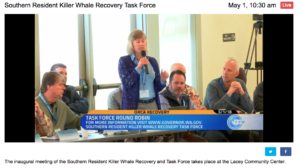
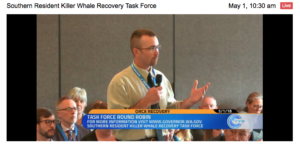
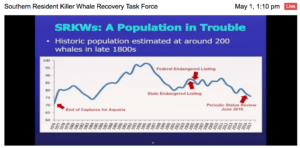
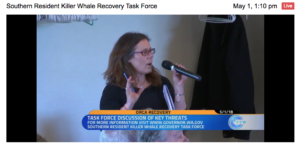
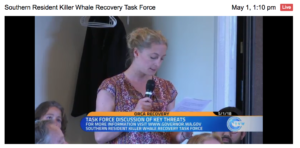

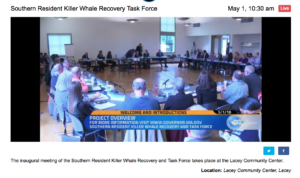
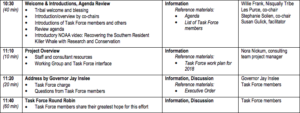

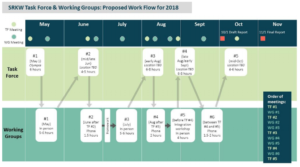

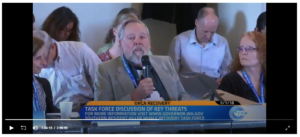


 Twitter
Twitter LinkedIn
LinkedIn Facebook
Facebook